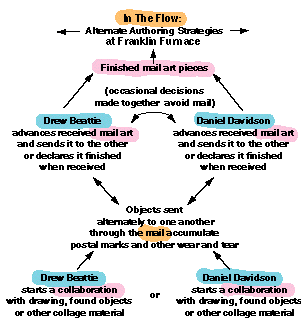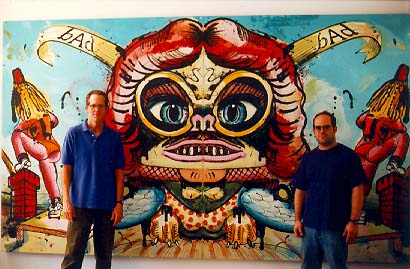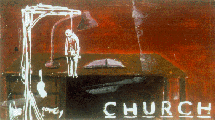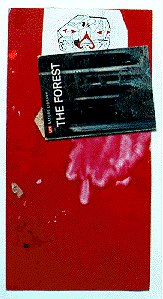

 |
 |
I talked with Daniel Davidson and Drew Beattie about their mail art after their show at Helman Gallery of large scale paintings made with an "ink blot" technique. My interest in their work for In The Flow comes not only from their commitment to collaboration and mail art as alternate authoring strategies, but also their attempt through the working process to develop new metaphors of the self in the imagery. In fact their idea of mail art is quite removed from the network-as-medium espoused by the Mail Art movement seen elsewhere in this exhibition. For Beattie and Davidson the mail acts more as a method to reduce their self-consciousness and preconceptions about a developing piece of art than to counteract the commodifying pressures of the art world. Key to their exploration of identity is the function of collaboration to release them and their audience from expectations of a single unified vision. As Beattie said in comparing their collaborative style with Gilbert and George, "The model for it was much more a kind of brain chatter. Not chatter in the derogatory sense, but just the multiplicity of things that anyone holds at a given moment in their self, their non- self, brain, soul, whatever you want to call it. We wanted to let that spill out in a way that would combine a lot of different things. " And Davidson, "The results for us just came in a more innocent or intuitive way. Less predetermined. We were thinking: What can we find together? What could we make together? Let's see where it goes...""
Georges: So what attracted you to mail collaboration?
Beattie: I was teaching at The Art Institute of San Francisco, Daniel was a student and he had a full-time job, so we had heavy schedules to keep up with, and the mail art became a way of extending the time. But as we were able to show the work and sell it, the amount of time in the studio erased the need for the mail art to be a practical answer to anything.... In its purest form, it reduces you back to the point of being able to act on something because you're visually excited about it. It's not so much a strategy for success.
Georges: In a lot of them there are references to games. Either the Hangman, or to aspects of the Surrealists' Exquisite Corpse, or "naughty boy" kinds of games, such as defacing pictures of famous people. And that gaming side, I assume, is part of the attraction..
Beattie: I think that was just a bluff. It was a way of getting going, a way of getting a plot in motion.
Georges: Going through the mail, is automatically about taking turns which is already game-like...
Beattie: I think that evolved too. At first it was very literal. We had a real system...
Davidson: Yeah, real rules to it...At the beginning, I would find something on the street, and I'd do something to it and mail it to Drew. He could do something to it and mail it back to me. The person who received it was the person who could say, "That's done." In other words, if I had drawn a rooftop on a house, I couldn't then, before I stuck it in the mailbox, decide "that's pretty good I want to keep it." I'd have to send it back to him. Then he could pull it, or vice-versa.
But what quickly happened was, we'd get ones--and sometimes any artist makes something and they kind of wonder, "God, what is this? I don't know..." I'd get a piece in the mail and I'd bring it down to the studio, or Drew would get one, and we'd say, "Hey what do you think of this thing right now? It looks pretty good..." Our rules, the literal rules of the game started to break down. And the actual complexity of what the art could really be started to take form.
Georges:
Often I see something that's relating to a game clearly, in the imagery...Davidson: Like the hangman theme...

Beattie: With the hangman, the thing that specifically appeals to us--more than the games between each other as a methodology--is that it has a bit of a [Jasper] Johns-like idea. With the flags, for example, he could make the flag painting and everybody knew it was a flag. So what his spin was on the known thing is where his content, his personal embodiment was laid down into the painting.
Georges: It's a foil...
Davidson: It's a structure. To use a sports analogy, a baseball game has a set of conventions and rules, and then every game is different.
Georges: It's an inherently collaborative structure, because it's something that occurs between people.
Beattie: And it's also a hybrid thing. When you think about it, it's a very bizarre game. It's about hanging someone. The combination of violence, humor, lyricism, all these spiky, awkward, aggressive things. It felt like a place and continues to be a place where a lot of the ideas and emotions and states of mind that we are curious about fusing--can come together.
But the one thing we've always done with the hangman is that it's a real live game. Whoever's guessing really is trying to guess the word, and whoever is drawing knows the word. So artistically, a lot of things happen by chance. Even if it's only because you're just playing a game.
Georges: So the rules become, as you say, a "structure" for a kind of improvisation.
Beattie: Exactly.
Georges: In a lot of the mailed pieces and also in the paintings, the images are partially covered over, distorted or crossed out. So much that they become almost as much about what can't be seen
--or what they may have been in the past during the course of this improvisation--as they are about what we actually see. As I look at them, I make correlations with psychological mechanisms like denial, repression and projection. I get the sense that a lot of your works are dealing with models of the mind...
Beattie: Even the thing about graffitiing over an image--and that's been something we've done a lot of--for us it's been less about the stance of bad-boy graffiti art, and more about fusing a layer of identity on top of a prior identity. The bad, distended Xerox of the model's face that becomes a pirate cartoon is both female and male and it's a third thing--what is that thing? All these labels are kind of stacked up on each other. The brain model would be more of a notion about multiple identity, and trying to break some of these labels down. Its kind of like finding the world in the making of the thing, so the cover-ups are almost like a compacted way of reading the time and the path that you went upon in order to end up at this place visually.
Beattie: Sometimes you just have to clear space for new things
Georges: Although, it must be easier to do it when it's not yours...
Beattie: That's one example of how, when it's removed from you [through the mail], the authorship is so blurred, that you don't know what it is until you go ahead and do whatever comes to mind. It's a state we always try to get ourselves into in the studio hours of the day, because it seems to offer the best of intuitions. But its sometimes hard to access; especially when the process is more conscious or it's on a bigger scale, or more expensive.
Georges: In the traditional idea of "good art" there is implicit an essential vision--some sort of truth--where the picture acts as a window onto the self. But from the start there are two of you and you say you are thinking of the image in terms of a multiplicity of identities. How do you see your relationship in what you do to "identity" or "identities" ?
Davidson: We certainly value and like work that's made by a single person under that idea of window-to-the-self. But when we were in Italy last year we saw this great mosaic that was made by a team of perhaps fifteen people. It had a kind of wholeness to it. It's a beautiful thing, a meaningful thing. Who's to say that it's a window on any one mind? Or in the tradition of painting where an assistant will paint everything and the artist comes along and paints the head. The figure still reads as a whole figure. Our collaboration doesn't work on that model, but I think the idea of it as a view on a single soul, is maybe not the only...
Beattie: Well for me, more and more, there is no single soul. There is no self, I don't exist. There is no Daniel Georges, and this is all a fiction; like so many of the labels that we live by, these are all comforting constructs that simply don't exist. That's why this whole business of authorship is so troubling. Well, not really troubling, but kind of exciting It makes you confront, "What is the thing that results? What is the connection between the thing and the maker, or makers, of the thing?"
Davidson: Maybe the content or the subject of the work--or the meaning of the work--is bigger or way beyond the person who made it.
Beattie: I just don't think there is a Drew Beattie. I don't think there is a Daniel Davidson. I think we're collections of all kinds of things, and we'll spend a lifetime trying to bump into the multiplicity that we are, trying to accept the multiplicity that we are.
Georges: The fragmentation we see in the mail work and in the paintings, is that an extension of that decentralized self?
Beattie: Yes, or Multiple interpretation, multiple self, multiple realities...
Georges: And yet your work is still very tactile and oriented towards the actual making of an object, and a beautiful object at that...
Beattie: There is a tension between making a compelling, believable, durable visual embodiment and doing something that we believe in along these lines of content concerning a decentralized, fractured metaphor of what we're seeing more as the nature of existence now. That's a real tension and I think we operate in the hotbox that it makes.
Georges: On the one hand, multiplicity implies that everything is relative, that there is no fixed meaning, but what you are saying is that in the end you want to make a painting that has some long-lasting, essential quality to it.
Beattie: When you look at our best things, you witness a kind of circuitry which draws you into a loop of possibilities. It doesn't have a fixed endpoint. It doesn't go from point "A" with its goal being point "G," and then you're at "G" and you got it and it's done. Along that route, along that circuitry, comes a multiple sampling of the things which actually make up a person's day and mind--a person's life--that's some kind of metaphor. It's an artistic metaphor that, if we can embody in a visual result, we'll have something we care about.
Davidson: To talk about it sounds like we've got this idea of "multiplicity", or "fractured", whatever--like we're trying to find something to illustrate that thinking. But when it looks right, it's more on a gut level.

Beattie: For instance, this piece of mail art has a collection of found, chance things: It's got this "Forest" book cover plowed right on to a red object from a Utrecht store display with a stain on it, a sort of cartoon that's been cut up and drawn over--and these things don't really cook down into a harmonized whole. They talk to one another and coexist with one another, and perhaps provide some kind of circuitry of stations along its loop that becomes a piece of work. Then again, maybe not. That's the gamble. Maybe not.
Georges: The pieces with this kind of fragmentation, that have this improvisational flow between the two of you are different from the blotted pieces where the double aspect of what you do is in there more formally. Doesn't knowing that there is a final mechanical event [of folding and blotting the wet canvas] that's going to create the bilateral symmetry make the process more inherently self-conscious? What is the relation of what you're communicating in those pieces, as opposed to the more floating montage spaces of your other work?
Davidson: At its best, the symmetrical thing was, again, a structure--A kind of process like the game of hangman: We had a set of conventions that didn't allow us to know where we were going to end up, but there was a structured path that one could get on, follow and respond to. It is mechanically structured to mirror and repeat itself, but within that limitation there's a range of what can happen. I think visually however--and surprisingly--the centeredness, the equilibrium of the symmetry does give it a look of intention.
Georges: How does that relate to what we were talking about before, of presenting images of self?
Beattie: you've seen these photos in magazines, where they put two left sides of Lyle Lovett's face together to make a whole Lyle Lovett. It doesn't look like Lyle Lovett anymore. It looks like this idiot kind of Lyle Lovett. It looks like a blank, impossible, idealized, who-are-you Lyle Lovett, and it's very mysterious...
Davidson: The hundred mile stare...
Beattie: The hundred mile stare, because there's nobody there. We're very interested in the blotted paintings, and we've been very curious in the reactions they have gotten. People in general have been put off, and in a way, that always disappoints you--because everybody wants to be loved--but on the other hand, you begin to get a little curious about it. When so many people look at them and find them upsetting, or different, or difficult or weird, sometimes that's interesting to you. The future blotter paintings will have more of a dialogue of symmetry and asymmetry in them, because it's all along--on the mail art level and on the drawing level--what they had. To turn them into big paintings involved discovering certain technical methods and those experiments ended up with visual results carrying a character which everybody has read as intention.
Georges:
Your imagery tends not to be lifted directly from the media. You might take something from a magazine, but generally you alter it pretty significantly. It's not like say Christian Shumann's work where characters or references are recognizable and relatively unchanged a lot of times...Davidson: We felt that the potential of the image was stronger, if you could look at it and say, "Yeah, it looks kind of familiar," but you couldn't really land on it. You couldn't say, "Oh, that's Mickey." All the associations with Mickey and Donald--on your watch, at Disneyland, the little kids' backpacks--are gone. You're in this world of familiar things, but you can't really place them.
Beattie: Characters like "Duck-boy", with a duck head and a plump figure, wearing some kind of swaddling clothes, usually with a big butt-cone on the back of it...
Davidson: A party hat strapped to his butt. Duck feet--Who is this guy?
Beattie: While we want this floating world of multiple reference, multiple identities--that operates in tension with a funny kind of melancholy. Often pieces are organized so that there comes to be a dominant character or two [e.g., 'Duck Boy'] which ride over and above the floating world of possible choices. There is a contradiction in what we do--between inviting multiplicity and wishing there was sometimes a more organizing presence which might be one of these larger characters. It's an analogous tension to the one you talked about before between these ideas about authorship and multiplicity, versus the traditional means of making a pictorial, painting-world.
Georges: So, maybe the melancholy is a longing for everything to be right...
Beattie: I think in some ways it is. Or for everything to be more knowable. Or to have a more complete meaning or more singular arrival, even as we're working against it in other ways. I think painting is a very tough area right now. You're very jostled about. It's not okay to do a lot of things. You're bound in many ways, being a contemporary painter: about exactly what constitutes a painting; about all the notions of beauty and richness and surface; if these notions are antique, or timely, or renewable; or even if they are simply part of a vanishing past--despite a certain conservative, moneyed audience which still continues to buy lush abstraction or detailed realism--that increasingly as the culture gets more sophisticated, that that kind of painting will die out because it will simply be like writing a note on a shovel instead of using a piece of paper.
Georges: There is a dialogue between you in making art which is communication, and then there is also what the work itself may communicate to people who are looking at it. How does authorship play a role in the complex of stuff you want to convey?
Beattie: One of the things we discovered early on was how much of one's work in regard to authorship was really a kind of personal therapy. A lot of artists are just out there scratching away at their stuff--happy about a good day, unhappy about a bad day and so on--when that often has very little to do with the merit of the art they make. So right away, in terms of an "alternate authoring strategy," we started to drift away from preoccupations that we weren't even aware we had before; such as monitoring the good or bad job we were doing. So collaborating got us to surrender more and more to the result, to what we were looking at...
Davidson: I think one thing we haven't really pinpointed, in terms of what we intend and in terms of what we wish people could get from our work, is a basic notion of what art is to us: What art is to us is an encoding of life experience abstractly. Its merit, its excitement, its discovery, its meaning all come back to how magically and with unbelievably limited means, a painting or a drawing can encode a sense of life experience. Nothing else could possibly be worth doing, in terms of an artistic intention.
Georges: Part of my question also, was that when people are looking at the work they look at the work. But then because it's by a collaborative, that conditions the way they look at it...
Davidson: maybe because I'm in a collaboration I don't have this prejudice, but when I look at other collaborative work that I really like, I don't like them simply because they're collaborative. I don't like or dislike collaborative pieces because they don't live up to my idea of what I think collaboration should look like. I believe I look at collaborative art because I like it as much as a Picasso, or whomever... It's not possible for people to do, but that would be my ideal wish: that people judged our work based just on the work, regardless of us, and whether they liked collaboration or not.